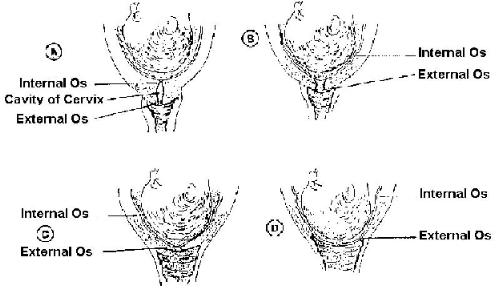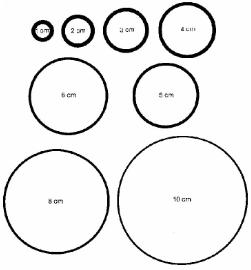This is the Archived Desktop Edition.
You should be transferred to the Newest Edition for Desktop and Mobile within 2 seconds.
Lesson 2: Stages of Labor and Nursing Care
a. The goal of any mother and health care team is the successful, uncomplicated birth of a new infant. Your understanding of the process of labor and what it entails will allow you to provide adequate comfort measures to the patient and to assist her through this long awaited event. Although much pain or discomfort may be experienced by the mother and those concerned, labor and delivery of an infant is an eventful time after a long nine months of pregnancy.
b. Labor is defined as the onset of rhythmic contractions and the relaxation of the uterine smooth muscles which results in effacement or progressive thinning of the cervix, and dilation or widening of the cervix (see figure 2-1). This process culminates with the expulsion of the fetus and expulsion of the other products of conception (placenta and membranes) from the uterus.

Figure 2-1. Stages of effacement and dilatation.
2-2. TRUE LABOR VS FALSE LABOR
Many women often experience "false labor" before "true labor" actually begins. False contractions may begin as early as three or four weeks before the termination pregnancy. Contractions, show, the cervix, and fetal movement all are vital in distinguishing between true and false labor (see Table 2-1).
|
FACTOR |
TRUE LABOR |
FALSE LABOR |
|
Contractions |
Produce progressive dilation and effacement of the cervix. Occur regularly and increase in frequency, duration, and intensity. |
Do not produce progressive dilatation and effacement. Are irregular and do not increase in frequency, duration, and intensity. |
|
Show |
Is present. |
Not present. May have brownish discharge that may be from vaginal exam if within the last 48 hours. |
|
Cervix |
Becomes effaced and dilates progressively. |
Usually uneffaced and closed. |
|
Fetal Movement |
No significant change, even though fetus continues to move. |
May intensify for a short period or it may remain the same. |
Table 2-1. True verses false labor.
a. Contractions.
(1) True labor. The contractions of true labor produce progressive dilatation and enfacement of the cervix. These contractions occur regularly and increase in frequency, duration, and intensity. The discomfort of true labor contractions usually starts in the back and radiates around to the abdomen and is not relieved by walking.
(2) False labor. False labor contractions are referred to as Braxton Hicks contractions. They do not produce progressive cervical effacement and dilatation. They are irregular and do not increase in frequency, duration, and intensity. Discomfort is located chiefly in the lower abdomen and groin area. Walking often offers relief.
b. Show. This is another sign of impending labor. After the discharge of the mucous plug that has filled the cervical canal during pregnancy, the pressure of the descending presenting part of the fetus causes the minute capillaries in the cervix to rupture. This blood is mixed with mucus and therefore has a pink tinge.
(1) True labor. Show is usually present in true labor. There will be pinkish mucus or a bloody discharge. This mucus or discharge may also be from the mucous plug from the cervix.
(2) False labor. Show is not present in false labor. However, the mother may have an old, brownish discharge especially if she had a vaginal exam within the last 48 hours.
c. Cervix.
(1) True labor. In true labor, the cervix becomes effaced and dilates progressively. This change can be identified within an hour or two.
(2) False labor. In false labor, the cervix is usually un-effaced and closed. There is no change identified if the cervix is rechecked in an hour or two.
d. Fetal Movement.
(1) True labor. There is no significant change in fetal movement even though the fetal continues to move.
(2) False labor. Fetal movement may intensify for a short period or it may remain the same.
2-3. OVERVIEW OF THE LABOR PROCESS-FOUR STAGES
a. First Stage of Labor. The first stage of labor is referred to as the "dilating" stage. It is the period from the first true labor contractions to complete dilatation of the cervix (10cm) (see figure 2-2). The forces involved are uterine contractions. The first stage of labor is divided into three phases:
(1) Latent (early) or prodromal.
(2) Active or accelerated.
(3) Transient or transitional.
b. Second Stage of Labor. The second stage of labor is referred to as the "delivery or expulsive" stage. This is the period from complete dilatation of the cervix to birth of the baby. The forces involved are uterine contractions plus intra-abdominal pressure.
c. Third Stage of Labor. The third stage of labor is referred to as the "placental" stage. This is the period from birth of the baby until delivery of the placenta. The forces involved are uterine contractions and intra-abdominal pressure.
d. Fourth Stage of Labor. The fourth stage of labor is referred to as the "recovery or stabilization" stage. This period begins with the delivery of the placenta and ends when the uterus no longer tends to relax. The forces involved are uterine contractions

Figure 2-2. Cervical dilatations.
The Brookside Associates Medical Education Division is dedicated to the development and dissemination of medical information that may be useful to medical professionals and those in training to become medical professionals. This website is privately-held and not connected to any governmental agency. The views expressed here are those of the authors, and unless otherwise noted, do not necessarily reflect the views of the Brookside Associates, Ltd., any governmental or private organizations. All writings, discussions, and publications on this website are unclassified.
© 2007 Medical Education Division, Brookside Associates, Ltd. All rights reserved